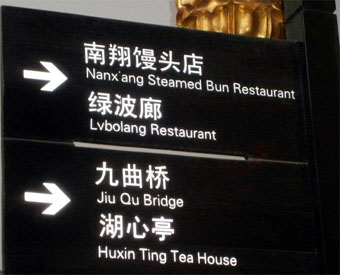
Pockets of Heaven:
The Best Stuff to Eat in China
| published November 6, 2015 |
By Michael Bush,Thursday Review writer
When I think back on the four years we lived in China, food is at the forefront of my memories. The sights were amazing. Learning Mandarin was challenging, but incredibly rewarding. The friends we made are irreplaceable, and have helped shaped who we now are. The culture shock, too, helped us adapt to world travel. But the food…the glorious food, oh how I miss that.
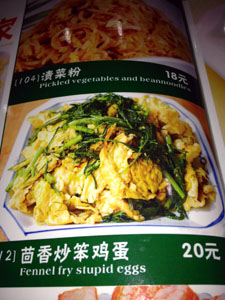
The food in China can be intimidating at first glance, especially when you realize that most places you go do not have an English menu. So if you don’t speak Chinese, you’re left with the hope that there are pictures on the menu, or you’re whipping out the smartphone to use Google Translate. Even if there are English descriptions, they can either be misleading, or just downright confusing as hell.
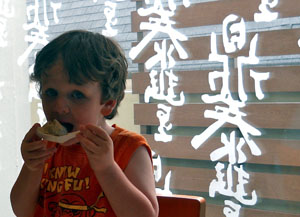
So one thing that most laowai (the Mandarin word for foreigner) feel comfortable ordering, and can be found almost anywhere, are dumplings. This, along with rice and noodles, are the safest bet when ordering for your kids, too. Dumplings come in a multitude of preparations with an even more impressively long list of fillings. China is rich with dumplings, my friends, and if you want to experience food nirvana… eat them…try them all, eat them all.
Jiaozi (饺子) are the most common type of dumpling you will find, and they are divided by how they are prepared: steamed, boiled and fried. The fried ones…I mean come on…they’re amazing and are known as guotie.
You can find guotie (锅贴), what we call potstickers in America, being fried in a wok right on the sidewalk as you stroll down the street. Buy a box, please. Just trust me. The browned skin from the high heat of the wok will crunch a little as you bite down, while the rest of the dumpling skin is silky soft. The fillings, varied as they are, explode in your mouth with intense flavors. Guotie are a thing of beauty. They are very easy to eat on the go—which makes them ideal if you are a business visitor or a tourist—and I’ve never met anyone that didn’t like them.
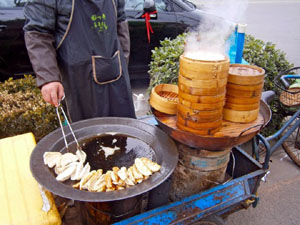
Another style, and a bit larger, are called baozi (包子). These are the steamed buns you see Chinese people in movies eating all the time; heck…even the Kung Fu Panda is always munching on them. They are big and soft, yet dense, and hold within their center a glorious surprise. My personal favorite is the spicy pickled vegetable filled baozi or the spicy ground beef. I’m also partial to one that has ground pork, with a quail egg buried in the center. Baozi are one of the most prevalent breakfast foods you will find on the streets of China. Cheap, filling…and delicious.
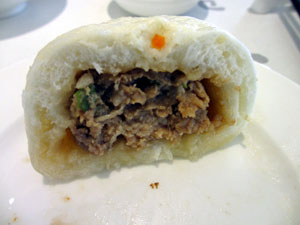
There are also shou mai (烧卖) dumplings. These are some of my wife’s favorites. They are open at the top, which means you can actually see what the filling is. Her favorite contain pork and rice, and are just fantastic. To me, shou mai are blander than it’s relatives in the dumpling family, but a quick dip in Chinese black vinegar changes that straight away.
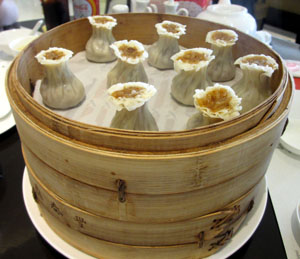
Now, I could go on all day about more and more and more dumplings. I could wax poetic about their steam that fills the air, the aroma that permeates your very soul, the life changing… mind altering… eye wateringly good world of dumplings. But I’m not going to do that. I’m going to skip to the end. I’m going right to the one that breathes life into the almost dying. The dumpling that creates new universes in another dimension filled with fantastic creatures every time you swallow a bite. I’m going to talk about xiaolongbao. (Go ahead, readers, check my spelling!)
I’ve mentioned them before in my writings. In Qibao, they have a very famous stall of crab xiaolongbao by the bridge. But, this time…it’s time to go deeper. A dumpling within a dumpling? Dumplinception?
Xiaolongbao, (小笼包) also known as soup dumplings, are a specialty of the Shanghai region. These special dumplings are believed to have started in a small water town (we talked about those before!) called Nanxiang, which is now part of Shanghai, as you can reach it via the metro on Line 11.

When talking about soup dumplings, you must first understand the wizardry it takes to create them. The meat and/or vegetable filling is mixed with a meat aspic, or gelatin, and refrigerated. The cold filling combined with this soup broth in gelatin form is then wrapped in dumpling skins and steamed in bamboo baskets. The heat melts the gelatinous soup into a boiling broth of Heaven that surrounds the filling.
Upon biting into this little pocket of Heaven, be forewarned: the contents are basically magma. It will burn your damn lips and tongue right off if you’re unprepared. The best tactic I’ve found, one that I was taught by locals, is to bite a bit of the skin off the top of the dumpling. Blow into the hole created by this bite to cool off the contents somewhat. Then suck the soup out through the hole. Now that you’ve gulped down the delicious soupy contents, it’s time to eat the rest of the dumpling and its delectable insides. But wait! One more step is needed to achieve full on deliciosity (a scientific term I just made up). Dip your xiaolongbao into the Chinese black vinegar (sometimes with sliced fresh ginger) and let that seep into the hole, filling the dumpling with a new and powerful liquid.
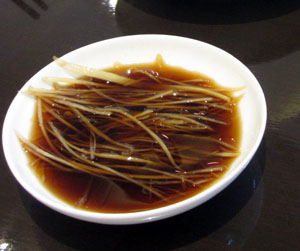
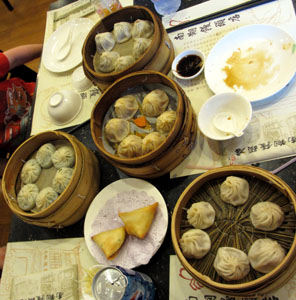
Boom! Your head just exploded from amazement. Get on a plane bound for China right now and order a table full of steamers. You will write me letters, begging me to let you pay me for my valuable advice. I will let you, don’t worry.
There is also a larger version of a soup dumpling called a tang bao (湯包), which has nothing but the soup inside…another great way to remove your soft palette if you’re not careful. And also there is a pan-fried version that has a really thick skin and is called sheng jian bao (生煎包). This dumpling, for me at least, is just too greasy. I’ll take the good ol’ regular xiaolongbao any day over this version.
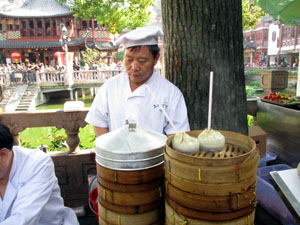
Since my family’s love of this little pocket of Heaven was so intense, we decided to try as many different varieties as possible. There are infinite shops selling their own take on xiaolongbao in Shanghai, and all are fantastic. But to the traveller visiting Shanghai for only a few days, they will always be directed to one of two restaurants: Nanxiang Steam Bun Co. (which shares a name with a certain water town that claims to have invented the xialongbao) or Din Tai Fung (which is actually a Taiwanese import).
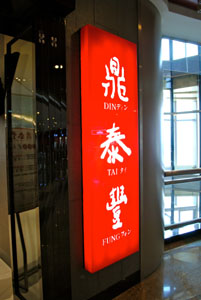
They are both fabulous, and I won’t pick sides here. Picking sides is not what this article is about. It’s about the glory that is the xiaolongbao. I will say that at the Nanxiang Steam Bun Co. (title photo), the dumpling skin is a little thicker and the soup more savory. At Din Tai Fung, the skin is delicate and almost paper thin, while the soup is a little bit sweeter.
In our valiant search for the best xiaolongbao, it struck my wife and I that to really experience this mystical creation, we would need to travel back in time…to go back to where it all began. So, we got on the Shanghai Metro Line 11, and headed to Nanxiang. Where we were going, we didn’t need roads.
The town was much like all other water towns; they all have the same stuff, you know? But this one has a claim to fame that we needed to experience. So we trod in, expecting to be disappointed or amazed. The truth is probably somewhere in the middle, I think. But to be honest it’s hard to remember that day. You see, this particular day we experienced our second harrowing ride through Shanghai in search of a hospital that would accept children.
The first time was during Year 1 in Shanghai, and involved a careless woman who bowled over my three year old while walking down the street. His hands were in his jacket pockets, and he couldn’t stop his fall. His chin hit the sidewalk first, and split open, revealing bone.
It was a nightmare. I grabbed Lucas up, and held him in my arms, desperately seeking a cab to take us to a hospital, while my wife screamed at the woman to leave us alone as she had already done enough. She seemed apologetic, but when someone hurts your kid, you want to hurt them back. And Chinese jail didn’t sound too good to either of us, you know?
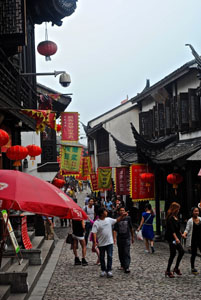
So, the second time we flew through Shanghai looking for a kid-friendly hospital occurred during this visit to Nanxiang. Lucas, always on an adventure of his own no matter where we go, was running through the cobbled streets of the ancient home of xiaolongbao.
When suddenly, his foot slipped and he fell head first onto a set of steps. Once again, my first-born, one third of my heart, was in my arms and bleeding profusely. The terror that visits me in those moments is visceral. It eats me up inside, and I begin to feel like a soup dumpling that has a hole already bitten in it, my courage pouring out into the street only to be refilled by the Chinese black vinegar known as fear.
After an hour in a taxi, us trying to keep him awake while Lucas kept falling asleep, and with makeshift bandage held to his head, we arrived at a hospital well known to us; the one where my second son was born. It’s not the greatest place in the world, as I’ll tell you more about it one day. But suffice it to say, he received four or five stitches in his head without anesthetic.
My brave and sweet little boy, four years after the first accident, was now writhing in pain as a needle threaded through his open wound. I held his hand and cried. But it all turned out ok. He doesn’t really remember that day too much, even though I still have nightmares about it.
And despite the awful events of that day, traumatizing though they were, all of us… Lucas included… would run madly, arms waving frantically, at the sight of a bamboo steamer full of real xiaolongbao.
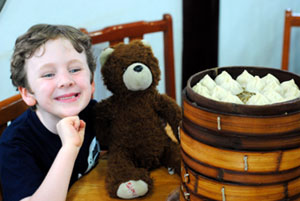
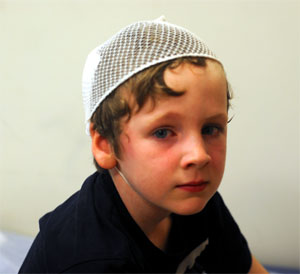
P.S.–I’ve just seen that a Din Tai Fung is coming to Penang, where we currently live. Vacation money has been reallocated as xiaolongbao money. Elastic banded shorts have been purchased. The Bush Family is READY.
Related Thursday Review articles:
Thank the Lord for Ice Cream; Michael Bush;Thursday Review; October 23, 2015.
The Giant: Gaining Weight in China; Michael Bush;Thursday Review; October 17, 2015.
